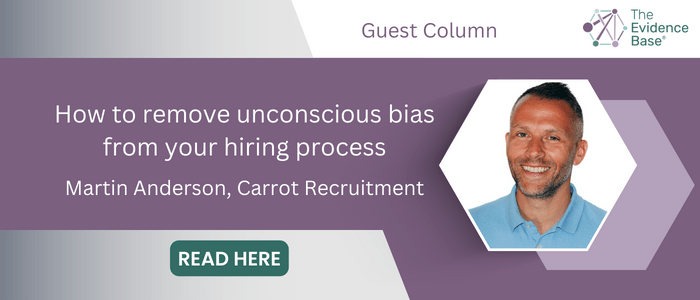How to remove unconscious bias from your hiring process

Diversity, equity and inclusion (DEI) are important elements for any serious business to consider. Martin Anderson (Founding Director, Carrot Recruitment) discusses how to bring this to the forefront of your recruitment strategy, and how to remove unconscious bias from the hiring process.
What is unconscious bias?
In real-world evidence (RWE) research, bias can have significant implications for healthcare equity, quality, and patient outcomes. Bias in RWE can arise from systematic errors in study design, data collection methods, sample selection, confounding variables, publication bias, and conflicts of interest among researchers or sponsors. Mitigating bias in RWE can be achieved by improving study design and methodology, enhancing data quality and integrity and ensuring representative sample populations.
Outside of healthcare research, in a recruitment context, when trying to attract and assess new talent for your team, bias can profoundly impact organizational diversity, employee satisfaction, and overall productivity. In particular, unconscious (or implicit) bias – a term that describes the associations we hold outside of our conscious awareness and control – can affect our interactions and our decisions. It can lead us to make assumptions and judgments about others based on our background, culture, and personal experiences.
In a recruitment context, it would refer to when hiring managers form opinions about a candidate based solely on initial impressions; for example, the hiring manager may unconsciously favour a candidate who belongs to the same social group or ethnicity as them over other candidates who may be more qualified.
Two big issues here – if this form of bias is present in your hiring process, then:
- you are not developing a diverse workforce, and
- you are potentially missing out on the best talent for that role.
But is it our unconscious or our subconscious at play?
This article began by talking about ‘unconscious bias’; however, I would argue that recruitment bias has much to do with the subconscious. How can we be aware of something if it’s unconscious? How do we know there is an issue, and how can we change?
There are three levels of consciousness in our mind. If we think of a house with three floors:
- The top floor is where we do our active thinking – what to wear, what to eat, etc – this is our conscious mind; we are fully aware of these thoughts and actions.
- On the middle floor we have our subconscious. Here we store information that we don’t need to access very often, like how to drive a car. Our brain has already learned how to do these things and has stored the information in our subconscious.
- Finally, the bottom floor is where the unconscious mind sits. Here we store information that we’re not aware of, such as deep fears, dreams, desires…. possibly things from our childhood. We have no control over our unconscious feelings because they are hidden from our conscious mind.
In summary, the conscious mind is what we’re actively thinking about, the subconscious is what we’ve learned and stored in our brain, and the unconscious is what we’re not aware of at all.
For the purposes of this article, I am choosing to use the term subconscious bias, as opposed to unconscious bias.
By being aware of and addressing your own subconscious biases, you can create a more equitable and inclusive workplace.
Some types of bias to be aware of:
- Gender Bias, Name Bias, Beauty Bias, Authority Bias, Ageism, Racism
- Perception Bias – Based on stereotypes
- Affinity Bias – Favoring people similar to you
- Anchor Bias – Using the first piece of information you receive as an anchor to base your decision on
- Status Quo Bias – Preference for things to remain as they are (e.g., always hiring from the same demographic)
- Recency Bias – Greater importance to more recent events as they are easier to remember
- Conformity Bias – Changing your opinions to match those of the group even if it doesn’t reflect your own opinion
- Halo Effect – When we develop an overall positive impression of someone due to one of their qualities or traits
- Horns Effect – Opposite to Halo. Negative impression of someone because of one trait or experience
Why is it important to remove subconscious bias from the recruitment process?
By tackling subconscious bias in a recruitment process, organizations can ensure that everyone is given an equal opportunity to be considered for a job. It can help companies create a diverse and inclusive workplace culture. This can lead to increased job satisfaction and productivity, improved employee engagement and retention, and enhanced customer experiences. These benefits in turn should effectively lead to better financial results for your company, so it also makes sense commercially.
In a healthcare setting, a more diverse workplace would better mirror the patient population that we are all ultimately supporting, whilst allowing us as organizations to be more empathetic towards them and more representative of them.
Taking steps to tackle subconscious bias will bring the following benefits:
- Attracts diverse talent, leading to new and fresh ideas/attitudes
- Fairer decision-making and inclusivity
- Encourages creativity and innovation
- Improves employee engagement
- Results in higher levels of productivity
- Increases company revenue
- Supports the implementation and growth of DEI policies
- A competitive edge over your competitors when it comes to attracting top talent
- Creates an unbiased culture where existing and new employees feel accepted
What can I do to remove subconscious bias from my hiring processes?
Here are several strategies to help mitigate subconscious bias in your hiring process:
Awareness and training: Begin by raising awareness among all team members involved in the hiring process about the existence and impact of subconscious bias. Conduct regular training sessions or workshops on subconscious bias to help team members recognize and address their biases.
Standardize job descriptions: Craft job descriptions that are gender-neutral and free from any biased language. Avoid using words that may attract or deter candidates based on their gender, race, or other personal characteristics. Neutral language in job adverts will help to appeal to a wider range of applicants. Use tools such as “Gender Decoder” https://gender-decoder.katmatfield.com/ to establish which words may have a gender bias.
Blind recruitment: Implement blind recruitment techniques where candidate information such as names, gender, and photos are removed from resumes or applications during the initial screening phase. This allows for more objective assessment based solely on qualifications, achievements, and relevant experience.
Structured interviews: Develop structured interview questions and evaluation criteria in advance, ensuring they are directly related to the job requirements. Use a consistent set of questions for all candidates and evaluate their responses using predefined criteria.
Diverse interview panels: Include a diverse group of interviewers to minimize the impact of individual biases. This can help provide different perspectives on candidate suitability.
Use assessments and tests: Incorporate skills assessments and job-related tests as part of the hiring process to evaluate candidates objectively. Examples would be to use set questions, so everyone has the same chance to demonstrate their capability or introducing “scorecards” so that each interviewee is screened equally.
Anonymous applications: Consider using a platform where candidates can apply anonymously to further reduce the influence of subconscious bias in the initial stages.
Data collection and analysis: Keep records of your hiring process to monitor diversity statistics at different stages. Regularly analyze this data to identify any potential bias hotspots in the process.
Feedback and calibration: Encourage interviewers to provide feedback on their assessments, and regularly review and calibrate the evaluation process to ensure fairness.
Continuous improvement: Commit to continuously review and improve your hiring process. Seek feedback from candidates and employees to make necessary adjustments.
Diversity and inclusion initiatives: Foster a diverse and inclusive workplace culture by implementing diversity and inclusion initiatives. A diverse workplace can help reduce biases over time.
Bias-mitigating technology: Explore the use of technology and software designed to reduce bias in the hiring process, such as AI tools that anonymize resumes or assess interview data for potential bias.
Legal compliance: Ensure that all your efforts to remove subconscious bias align with local employment laws and regulations. This is also hugely beneficial if you are ever challenged or accused of being biased in your screening or interview stages.
Ready to start removing subconscious bias from your recruitment process?
Truly eliminating subconscious bias can be challenging, but by implementing these strategies and fostering a culture of inclusion, you can significantly reduce its impact on your hiring process.
By regularly assessing and adapting your strategies to stay up to date with best practices in diversity and inclusion, you will create a more equitable workplace with a much happier workforce.
At Carrot we understand the need to remove bias of any kind from hiring processes and work hard to do so both internally and also on behalf of our clients. We can also provide help and guidance to improve staff retention, employee engagement, and candidate attraction.
We are passionate about client and candidate experience, and this is the backbone of everything we do.
We hope this article has illustrated the clear benefits of creating a recruitment process that is proactive and progressive against the use of bias.
Please view Carrot Recruitment as an extra resource within The Evidence Base community – we are happy to offer advice on anything related to your talent strategy and happy to set up informal conversations should you require any support or guidance.
If you are looking to grow your team or need to speak to us about our staffing solutions, please get in touch. We offer a range of permanent and contract recruitment services and can adapt our approach easily to fit with your resourcing requirements.

Author
Martin Anderson, Founding Director
Martin formed Carrot Recruitment in 2006 having spent nine years in life science consulting and industry positions, initially with the Adelphi Group in Patient Outcomes and Business Intelligence, and then in commercial roles at Merck Serono. He co-leads the business strategically whilst remaining very active at a senior level within the Market Access, HEOR & RWE space, partnering with clients exclusively to source exceptional talent. Martin also consults with businesses around their talent brand and recruitment processes, offering reviews and strategic direction to help them differentiate their proposition to the talent market.
[email protected]; +44 (0)7786 024 142
Sponsorship for this Guest Column was provided by Carrot Recruitment.
To learn more about Carrot Recruitment, visit its company profile.

